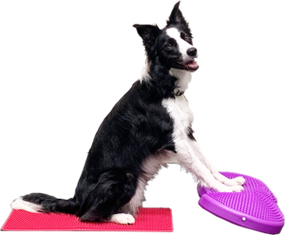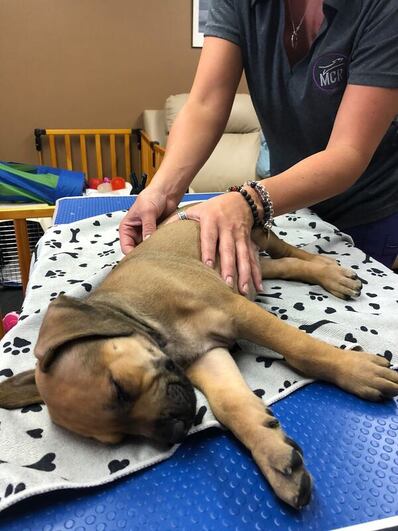|
Do you know that breeders can greatly affect a dog's athletic potential? Choosing the right dam and stud with good genetics and great sporting potential is but one factor (albeit an important one!) in determining a puppy's potential for athleticism but another, equally important factor, is how puppies are reared in their early development. Setting Puppies up for SuccessThere's growing research showing that breeders can do a lot to help prevent the development of hip dysplasia (HD) and prepare young dogs for an active sporting life starting right from the whelping box up to the day they go home with their new owner. Research has shown that hip joints are typically normal at birth and that the most critical time for the development and stability of the hip joint is from birth to 60 days of age (Krontveit et al.). Guidelines for Reducing the Incidence of HD in PuppiesThe Whelping Box
Get Outdoors! When puppies eyes begin to open and they begin to walk its time to start getting them outside to play and explore. Introducing different surfaces (i.e grass, pea gravel, mud, dirt, small puddles, leaves, hills ... etc). A study found that there was a seasonal variance that affected the development of HD in young dogs. Dogs born in the spring and summer had a lower incidence of HD at the 12- or 18-month radiograph. Dogs born in the fall and winter and who used stairs daily during the period of weaning to 3 months of age had an increased risk of developing HD. The researchers hypothesised that puppies in more rural areas had a greater opportunity for unrestricted play than their urban counterparts which decreased the risk of the rural pup from later development of HD. Urban pups, who had less access to unrestricted play also had a higher instance of climbing on stairs. Play on softer ground (such as in the spring and summer) was thought to have had a beneficial impact on muscle development and strength which could have contributed to the reduction of risk in developing HD later in life. Block the Stairs but do Introduce Challenge!Research shows that puppies < 3 months old should not be allowed access to stairs! This is especially true for a large or giant breed of puppy. Repetitive stress can greatly affect growth plates so targeted free time where pups can self regulate their activity is important. During this targeted free time, breeders should try and have a goal of enhancing coordination, building muscle, and introducing sensory stimuli. In the video below we catch up with the Labrador Retriever litter during some outdoor time. The breeder introduced a number of items and sensory stimuli for the litter.  There are a number of things breeders can do to help their puppies become well-rounded adult dogs. Try including:
Puppy Evaluations Getting puppies checked out by a rehab therapist is a smart idea! Puppies are clumsy; it's part of their charm!! However, having your dog checked by a qualified health professional early in their life can decrease the chance of an potential injury or the puppy growing in an unbalanced or unsymmetrical way. I highly recommend that breeders bring in their litter of puppies for a full assessment when they are about 7-8 weeks of age, just before they head off to their new home. In many of my litter assessments, I find about half the puppies have small issues in their pelvis or spine, which are treatable!! What happens if these are not addressed at this age? For example, a puppy who has a pain in their pelvic region could have a standing posture that is not symmetrical which can cause early muscle tightness and long term posture changes. OR, a puppy could have an ache in their back (from all the rough housing with their litter mates) that could change how the muscles in their spine develop over time, especially if left untreated. During an evaluation the therapist will check:
Starting early with a rehab professional can help build a lifetime relationship - we are here for you and your pup to make sure you are confident in making safe choices in their early development with the activities you do with them. An assessment prior to leaving to their forever home will give both you and the breeder piece of mind knowing all the ins and outs of a puppy that you are about to dedicate a lot of love and time with. Early assessments give your new pup a great start to an athletic life! An assessment also gives you the opportunity to learn additional information to help keep your new pup moving at its best and injury free. Identifying any potential issues early is critical for helping your pup grow properly and ensuring they can maintain their active sporting life while minimizing injury. Helping The Puppy OwnerAs a rehab professional I want each and every puppy to succeed and it all starts at the whelping box! There's a lot of advice out there but by relying on evidence based research as guidelines for rearing our pups we can set them up for success. Prospective sport puppy owners will also want to know what their pups have learned and experienced in the time they spent with their litter and these tips and trick can definitely help these owners when making the choice on which breeder to go to! Make sure to come back next week and let your puppy owner's know that I'll be writing a part two to this blog which will focus on what puppy owners can do with their young dog after they come home from the breeder! SourcesKrontveit, Randi I., and Ane Nødvedt, Bente K. Sævik, Erik Ropstad, and Cathrine Trangerud. “Housing – and exercise-related factors associated with the development of hip dysplasia as determined by radiographic evaluation in a prospective cohort or Newfoundlands, Labrador Retrievers, Leonbergers, and Irish Wolfhounds in Norway,” AJVR 73:6 (2012), 838- 846 (Link: https://pdfs.semanticscholar.org/…/ac69b28262d0fede3f98767d…)
3 Comments
Alisa Saraceni
11/20/2021 04:13:21 am
A very informative article!
Reply
6/6/2022 10:31:50 am
Very much appreciated. Thank you for this excellent article. Keep posting!
Reply
Leave a Reply. |
AuthorCarolyn McIntyre Archives
March 2024
Categories
All
|




 RSS Feed
RSS Feed